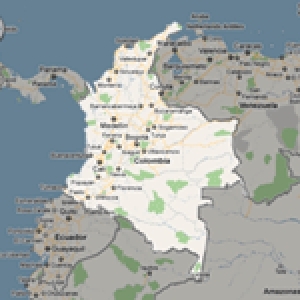With the end of 2010 comes a glut of statistics about rising versus decreasing crime rates across the hemisphere. In Mexico, most of the coverage has lamented skyrocketing murder rates in cities like Juarez. But in Colombia, government agencies have not had a difficult time presenting the year as a success in terms of security gains.
Government forces made two hugely significant advances: the death of guerrilla commander “Mono Jojoy” and neo-paramilitary leader Pedro Oliviero Guerrero, alias “Cuchillo.” The police and military have trumpeted other achievements from 2010, like the arrests of 2,563 alleged members of criminal gangs, and the seizure of 76.8 tons of cocaine.
But when it comes to the fight against organized crime, numbers aren’t always the best way to measure success (or failure). The 2,563 arrests in Colombia in 2010, for example, does not explain how many of the detainees were actually tried and sentenced. The deaths of top commanders like “Mono Jojoy” and “Cuchillo,” while signaling how greatly the security forces have improved their intelligence-gathering abilities, have not spelled out the end for either the Revolutionary Armed Forces of Colombia (FARC) FARC or the Popular Revolutionary Antiterrorist Army of of Colombia (ERPAC). And of course statistics on drug seizures can never account for how much of the product is actually getting through to foreign markets.
InSight Crime has compiled these numbers, released by security agencies to Colombian media, in order to provide more shading and perspective to the Colombian drug war in 2010, and better highlight what may await in 2011.
Drug Eradication
From Colombia’s anti-narcotics police, published by El Tiempo:
- 42,491 hectares of coca eradicated manually
- 101,171 hectares of coca eradicated aerially
- 706 hectares of poppy eradicated manually
- 207 hectares of marijuana eradicated manually
42,491 coca hectares eliminated manually is about a 20,000 decrease from 2009. This falls short of the government’s annual goal of eliminating 80,000 hectares of coca with eradication teams, although police did surpass the goal of aerially fumigating 100,000 hectares. Tumaco, Nariño, and Caceres, Antioquia, saw the greatest eradication campaigns. These are two regions where some of Colombia’s wealthiest drug-trafficking groups are entrenched: the Rastrojos in Nariño and the FARC’s 36th Front in northern Antioquia, respectively.
In 2011, one key area to watch is whether guerrilla attacks of eradication teams will continue to increase. Police say that 23 people were killed last year in guerrilla attacks while clearing coca fields. Another 147 people were wounded, either from sniper fire or anti-personnel mines planted by the FARC or ELN. The government has adopted manual eradication as an alternative to aerial fumigations, still an unpopular and politically sensitive approach. But especially in places like Nariño and Antioquia, manual eradication teams have become an obvious target for the weakened guerrillas, who are intent on protecting their finances and harassing the security forces with the fewest possible resources.
The FARC
From the Army, published by El Espectador.
- 483 guerrillas killed in combat (453 members of the FARC and 30 to the ELN)
- 5,045 guerrillas arrested
- 1,690 demobilizations
- 22,207 improvised explosive devices (IEDs) disabled
- 184 mine fields cleared
These numbers can be better understood when contrasted with the losses suffered by security forces in 2010. According to the President’s Office, more than 450 police and military officers were killed and over 2,000 were wounded in guerrilla attacks. 2010 saw nearly the same casualty rate as 2002, when the government broke peace negotiations with the FARC and Alvaro Uribe entered office. The FARC suffered serious setbacks in 2010, but given their increased reliance on landmines and IEDs, they are still quite capable of harassing the security forces in certain rural areas, especially the departments of Nariño, Cauca, Huila, Meta and Arauca. Hit-and-run attacks and anti-personnel mines, which accounted for 25 percent of the injuries suffered by soldiers and police, will likely become even more common in 2011 if the FARC continue stepping up their offensive.
Crime
From the police:
- 15,238 homicides (3.6 percent less than 2009, or 32 per 100,000 inhabitants)
- 12,472 robberies
2010 saw the lowest homicide rate per 100,000 inhabitants in the last five years, if we compare the police numbers with those compiled by the national coroner’s office, Medicina Legal. Still, Colombia’s homicide rate is dramatically higher than Mexico, which registered 15 murders per 100,000 people. Urban homicides are a particular cause for concern, with 88 murders registered per 100,000 people in Medellin, 80 in Cali and 31 in Barranquilla. These numbers mean that reducing urban crime will likely remain a top priority for President Santos’ administration next year. But it remains to be seen if the battle in the cities will drain resources from the battle in the countryside against the FARC.

